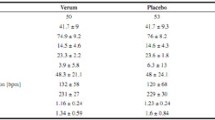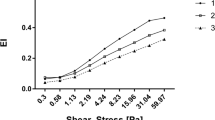Abstract
Recent connections between platelet activity and cardiovascular disease have raised questions of whether platelet function varies in exercising individuals. Resistance training has been linked to a possible reduction in hyper-aggregability of platelets, especially following acute strenuous exercise. The present investigation was designed to explore the effects of an acute resistance exercise test on the primary hemostatic system in both resistance-trained (RT) and untrained (UT) individuals. Ten RT (five men and five women; age, 26.0 ± 4.5 years; height, 175.12 ± 8.54 cm; weight, 79.56 ± 13.56 kg) and ten UT (five men and five women; age, 26.4 ± 6.2 years; height, 170.31 ± 7.45 cm; weight 67.88 ± 16.90 kg) individuals performed an Acute Exhaustive Resistance Exercise Test (AERET; six sets of ten repetitions of squats at 80 % of the 1-Repetition Maximum (RM)). Blood samples were obtained before, immediately after, and at 15, 60, and 120 min following the AERET. Blood samples were analyzed for platelet count, von Willebrand factor antigen (vWF:Ag), beta-thromboglobulin (β-TG), and platelet factor 4 (PF4). B-TG showed significant differences (p < 0.05) between RT and UT at +15 and +60 min. Both groups showed a main effect for time in platelet count, vWF, and β-TG following the AERET, whereas PF4 remained unchanged. All blood variables returned to baseline 120 min after exercise. Compared with UT, RT demonstrated reduced platelet activation in response to an acute bout of heavy resistance exercise. Reduced platelet activation may be attributed to training status, as shown by a reduction in plasma concentrations of B-TG in the RT group.




Similar content being viewed by others
References
Ahmadizad S, El-Sayed MS (2003) The effects of graded resistance exercise on platelet aggregation and activation. Med Sci Sports Exerc 35:1026–1032
Ahmadizad S, El-Sayed MS, Maclaren DP (2006) Responses of platelet activation and function to a single bout of resistance exercise and recovery. Clin Hemorheol Microcirc 35:159–168
Bergmeyer HU (1974) Methods of enzymatic analysis. Academic Press, New York
Bobeuf F, Labonte M, Khalil A, Dionne IJ (2009) Effect of resistance training on hematological blood markers in older men and women: a pilot study. Curr Gerontol Geriatr Res 2009:156820
Bourey RE, Santoro SA (1988) Interactions of exercise, coagulation, platelets, and fibrinolysis–a brief review. Med Sci Sports Exerc 20:439–446
Catto AJ, Carter AM, Barrett JH, Bamford J, Rice PJ, Grant PJ (1997) von Willebrand factor and factor VIII: C in acute cerebrovascular disease. Relationship to stroke subtype and mortality. Thromb Haemost 77:1104–1108
Chamberlain KG, Tong M, Penington DG (1990) Properties of the exchangeable splenic platelets released into the circulation during exercise-induced thrombocytosis. Am J Hematol 34:161–168
De Scalzi M, Cinelli P, de Leonardis V et al (1987) Response of some haemocoagulatory and haemorheological variables to maximal exercise in sedentary and active subjects. J Int Med Res 15:361–367
deJong AT, Womack CJ, Perrine JA, Franklin BA (2006) Hemostatic responses to resistance training in patients with coronary artery disease. J Cardiopulm Rehabil 26:80–83
Eisman R, Surrey S, Ramachandran B, Schwartz E, Poncz M (1990) Structural and functional comparison of the genes for human platelet factor 4 and PF4alt. Blood 76(2):336–344
El-Sayed MS, Ali N, El-Sayed Ali Z (2005) Aggregation and activation of blood platelets in exercise and training. Sports Med 35:11–22
Folsom AR, Arnett DK, Hutchinson RG, Liao F, Clegg LX, Cooper LS (1997) Physical activity and incidence of coronary heart disease in middle-aged women and men. Med Sci Sports Exerc 29:901–909
Gawaz M (2006) Platelets in the onset of atherosclerosis. Blood Cells Mol Dis 36:206–210
Gawel MJ, Glover V, Burkitt M, Sandler M, Rose FC (1981) The specific activity of platelet monoamine oxidase varies with platelet count during severe exercise and noradrenaline infusion. Psychopharmacology 72:275–277
Goto S, Ikeda Y, Murata M et al (1992) Epinephrine augments von Willebrand factor-dependent shear-induced platelet aggregation. Circulation 86:1859–1863
Haber P, Silberbauer K, Sinzinger H (1980) Quantitative studies on reversible thrombocyte aggregation during exertion]. Schweiz Med Wochenschr 110:1488–1491
Hunter GR, Kekes-Szabo T, Snyder SW, Nicholson C, Nyikos I, Berland L (1997) Fat distribution, physical activity, and cardiovascular risk factors. Med Sci Sports Exerc 29:362–369
Kaplan KL, Owen J (1981) Plasma levels of beta-thromboglobulin and platelet factor 4 as indices of platelet activation in vivo. Blood 57:199–202
Kestin AS, Ellis PA, Barnard MR, Errichetti A, Rosner BA, Michelson AD (1993) Effect of strenuous exercise on platelet activation state and reactivity. Circulation 88:1502–1511
Kraemer WJ, Ratamess NA (2005) Hormonal responses and adaptations to resistance exercise and training. Sports Med 35(4):339–361
Kraemer WJ, Ratamess NA, Fry AC, French DA (2006) Strength training: development and evaluation of methodology. In: Maud PJ, Foster C (eds) Physiological assessment of human fitness. Human Kinetics Publishers, Champaign, pp 119–150
Kulaputana O, Macko RF, Ghiu I, Phares DA, Goldberg AP, Hagberg JM (2005) Human gender differences in fibrinolytic responses to exercise training and their determinants. Exp Physiol 90:881–887
Kupchak BR, Creighton BC, Aristizabal JC, Dunn-Lewis C, Volk BM, Ballard KD, Comstock BA, Maresh CM, Kraemer WJ, Volek JS (2013) Beneficial effects of habitual resistance exercise training on coagulation and fibrinolytic responses. Thromb Res. doi:10.1016/j.thromres.2013.02.014
Lehmann M, Hasler K, Bergdolt E, Keul J (1986) Alpha-2-adrenoreceptor density on intact platelets and adrenaline-induced platelet aggregation in endurance- and nonendurance-trained subjects. Int J Sports Med 7:172–176
Levine SP, Suarez AJ, Sorenson RR, Raymond NM, Knieriem LK (1984) Platelet factor 4 release during exercise in patients with coronary artery disease. Am J Hematol 17:117–127
Massberg S, Schulz C, Gawaz M (2003) Role of platelets in the pathophysiology of acute coronary syndrome. Semin Vasc Med 3:147–162
Mazzeo RS (1991) Catecholamine responses to acute and chronic exercise. Med Sci Sports Exerc 23:839–845
Mendis S, Puska P, Norrving B (eds) (2011) Global Atlas on cardiovascular disease prevention and control. WHO, Geneva
Morris JN, Clayton DG, Everitt MG, Semmence AM, Burgess EH (1990) Exercise in leisure time: coronary attack and death rates. Br Heart J 63:325–334
Nash GB, Watts T, Thornton C, Barigou M (2008) Red cell aggregation as a factor influencing margination and adhesion of leukocytes and platelets. Clin Hemorheol Microcirc 39:303–310
Noble BJ, Borg GA, Jacobs I, Ceci R, Kaiser P (1983) A category-ratio perceived exertion scale: relationship to blood and muscle lactates and heart rate. Med Sci Sports Exerc 15(6):523–528
Paton CM, Nagelkirk PR, Coughlin AM et al (2004) Changes in von Willebrand factor and fibrinolysis following a post-exercise cool-down. Eur J Appl Physiol 92:328–333
Peat EE, Dawson M, McKenzie A, Hillis WS (2010) The effects of acute dynamic exercise on haemostasis in first class Scottish football referees. Br J Sports Med 44:573–578
Placanica G, Migliau G, Nasso G, Rosso R, Tallarico D, Migliau G (1999) Short-term effect of exercise on platelet factor 4 in normal subjects and in patients with coronary artery disease. Cardiologia 44:993–996
Prisco D, Paniccia R, Bandinelli B et al (1998) Evaluation of clotting and fibrinolytic activation after protracted physical exercise. Thromb Res 89:73–78
Rakobowchuk M, McGowan CL, de Groot PC, Hartman JW, Phillips SM, MacDonald MJ (2005) Endothelial function of young healthy males following whole body resistance training. J Appl Physiol 98:2185–2190
Sadler JE (2009) Low von Willebrand factor: sometimes a risk factor and sometimes a disease. Hematology Am Soc Hematol Educ Program 106–112
Schaffner A, Augustiny N, Otto RC, Fehr J (1985) The hypersplenic spleen. A contractile reservoir of granulocytes and platelets. Arch Intern Med 145:651–654
Strauss WE, Cella G, Parisi AF, Sasahara AA (1985) Serial studies of platelet factor 4 and beta thromboglobulin during exercise in patients with coronary artery disease. Am Heart J 110:293–299
Thompson PD, Franklin BA, Balady GJ et al (2007) Exercise and acute cardiovascular events placing the risks into perspective: a scientific statement from the American Heart Association Council on Nutrition, physical activity, and metabolism and the council on clinical cardiology. Circulation 115:2358–2368
Tofler GH, Muller JE (2006) Triggering of acute cardiovascular disease and potential preventive strategies. Circulation 114:1863–1872
Tomasiak M, Stelmach H, Rusak T, Ciborowski M, Radziwon P (2008) Vasopressin acts on platelets to generate procoagulant activity. Blood Coagul Fibrinolysis 19:615–624
Vona M, Codeluppi GM, Iannino T, Ferrari E, Bogousslavsky J, von Segesser LK (2009) Effects of different types of exercise training followed by detraining on endothelium-dependent dilation in patients with recent myocardial infarction. Circulation 119:1601–1608
Wang JS, Cheng LJ (1999) Effect of strenuous, acute exercise on alpha2-adrenergic agonist-potentiated platelet activation. Arterioscler Thromb Vasc Biol 19:1559–1565
Wang JS, Jen CJ, Chen HI (1995) Effects of exercise training and deconditioning on platelet function in men. Arterioscler Thromb Vasc Biol 15:1668–1674
Wang JS, Li YS, Chen JC, Chen YW (2005) Effects of exercise training and deconditioning on platelet aggregation induced by alternating shear stress in men. Arterioscler Thromb Vasc Biol 25:454–460
Womack CJ, Paton CM, Coughlin AM et al (2003) Coagulation and fibrinolytic responses to manual versus automated snow removal. Med Sci Sports Exerc 35:1755–1759
Zhao R, Kameneva MV, Antaki JF (2007) Investigation of platelet margination phenomena at elevated shear stress. Biorheology 44:161–177
Acknowledgments
The authors are grateful to our research and medical staff and to a dedicated group of test subjects for their participation in the study. Current Address: Dr. Juan Aristizabal School of Nutrition and Dietetics, University of Antioquia, Carrera, 75 #56-87, Medellin, Columbia.
Conflict of interest
The authors declare that they have no conflict of interest.
Author information
Authors and Affiliations
Corresponding author
Additional information
Communicated by Dag Linnarsson.
Rights and permissions
About this article
Cite this article
Creighton, B.C., Kupchak, B.R., Aristizabal, J.C. et al. Influence of training on markers of platelet activation in response to a bout of heavy resistance exercise. Eur J Appl Physiol 113, 2203–2209 (2013). https://doi.org/10.1007/s00421-013-2645-4
Received:
Accepted:
Published:
Issue Date:
DOI: https://doi.org/10.1007/s00421-013-2645-4




